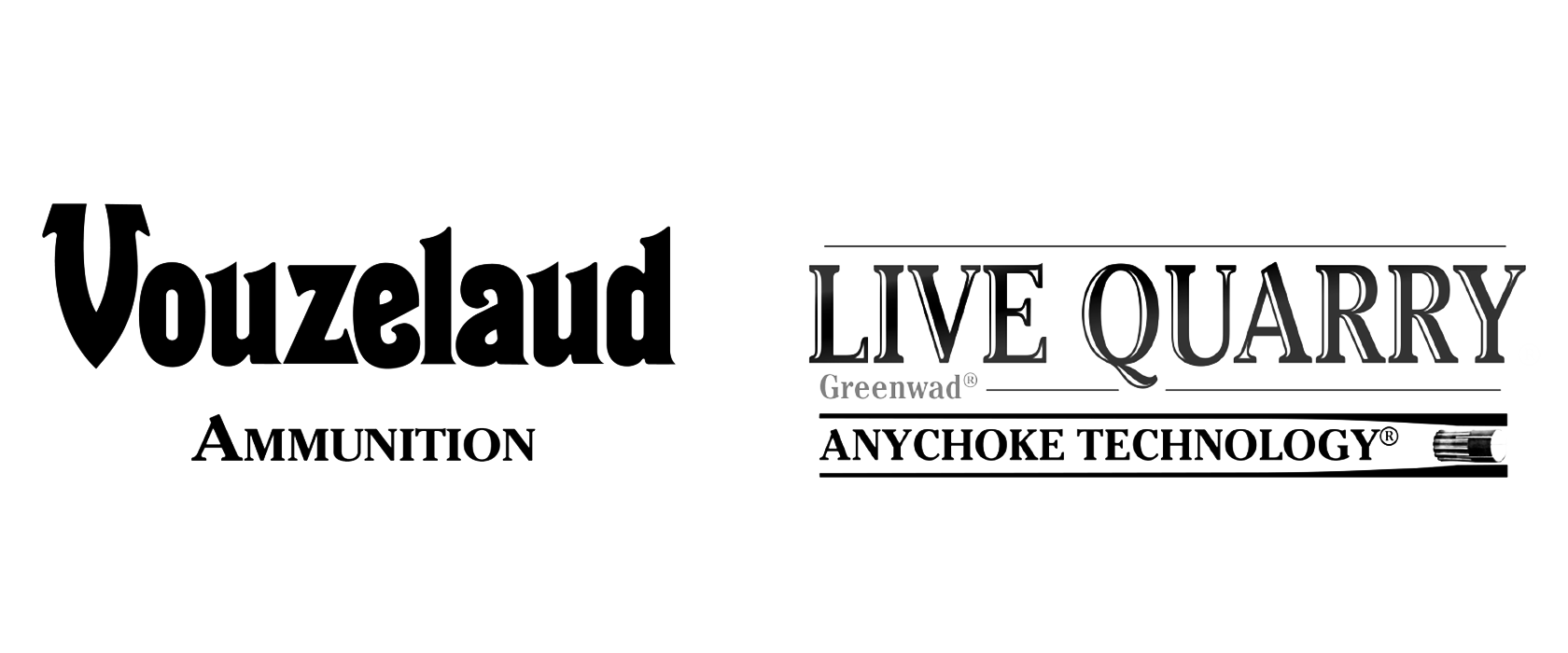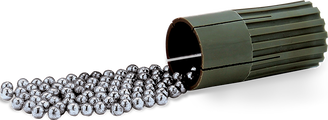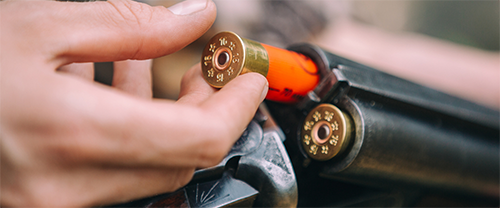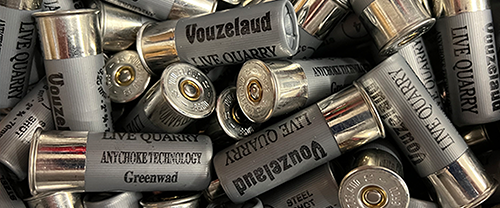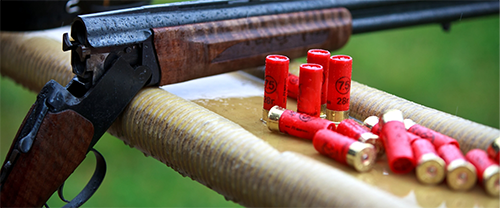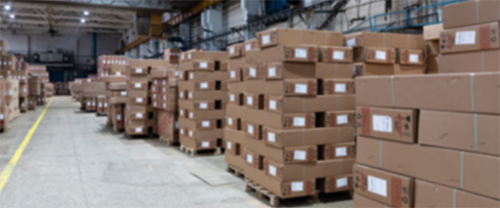ALWAYS READ THE USER GUIDANCE!
The Challenges of Steel Shot Cartridges
"Lead is softer and denser than steel."
In essence, it is this sentence alone that creates a number of challenges for shooters, gunmakers and cartridge manufacturers.
For the shooters, they must consider the performance of their chosen ammunition to take live game and the ability of their gun to take steel shot cartridges.
For the gunmakers, there is a series of challenges concerning proof, barrel specifications and the materials used in the manufacture process.
For the cartridge manufacturers, they must be able to create a range of steel shot cartridges to suit the shooters' needs, the requirements of guns not set up to take steel shot, the added performance issues and the guidance concerning single use plastics. Steel performs better with a plastic wad, but if plastic cannot be used, then alternatives must be found.
For a number of years, cartridge manufacturers around the world have put much money and time into the research and development of steel shot ammunition, with varying levels of success. As we approach the age of non-toxic shot live quarry shooting, there is still no "one size fits all" solution.
However, French gunmaker and cartridge manufacturer, Armurerie Vouzelaud, has spent over a decade perfecting a market leading product that can now be offered to British shooters.
We are proud to present the LIVE QUARRY range of steel shot ammunition.
In essence, it is this sentence alone that creates a number of challenges for shooters, gunmakers and cartridge manufacturers.
For the shooters, they must consider the performance of their chosen ammunition to take live game and the ability of their gun to take steel shot cartridges.
For the gunmakers, there is a series of challenges concerning proof, barrel specifications and the materials used in the manufacture process.
For the cartridge manufacturers, they must be able to create a range of steel shot cartridges to suit the shooters' needs, the requirements of guns not set up to take steel shot, the added performance issues and the guidance concerning single use plastics. Steel performs better with a plastic wad, but if plastic cannot be used, then alternatives must be found.
For a number of years, cartridge manufacturers around the world have put much money and time into the research and development of steel shot ammunition, with varying levels of success. As we approach the age of non-toxic shot live quarry shooting, there is still no "one size fits all" solution.
However, French gunmaker and cartridge manufacturer, Armurerie Vouzelaud, has spent over a decade perfecting a market leading product that can now be offered to British shooters.
We are proud to present the LIVE QUARRY range of steel shot ammunition.
Shot Size and Load
Since steel is less dense than lead, a lower load may be used than a lead cartridge with an equivalent pellet count. However, steel shot being lighter also requires a larger shot size. These factors combine to provide a benefit to any steel shot cartridge: less load for the same amount of pellets and therefore more powder to keep performance at its maximum.
LIVE QUARRY (a 2 3/4" cartridge) is produced in a 28g No.4 (French). This pellet is 3.25mm in diameter, equivalent to a UK No.3. The average pellet count is 200 per cartridge, which is similar to a British lead shot cartridge in a 34g No.4.
LIVE QUARRY VINTAGE (a 2 1/2" cartridge) is produced in a 24g No.5 (French). This pellet is 3mm in diameter, equivalent to a UK No.4. The average pellet count is 218 per cartridge, which is similar to a British lead shot cartridge in a 28g No.5.
LIVE QUARRY (a 2 3/4" cartridge) is produced in a 28g No.4 (French). This pellet is 3.25mm in diameter, equivalent to a UK No.3. The average pellet count is 200 per cartridge, which is similar to a British lead shot cartridge in a 34g No.4.
LIVE QUARRY VINTAGE (a 2 1/2" cartridge) is produced in a 24g No.5 (French). This pellet is 3mm in diameter, equivalent to a UK No.4. The average pellet count is 218 per cartridge, which is similar to a British lead shot cartridge in a 28g No.5.
ACP Wad and Anychoke Technology
The key to LIVE QUARRY's success is its patented ACP wad. The ACP wad is the central part of Vouzelaud's groundbreaking ANYCHOKE TECHNOLOGY.
The reason why steel shot cannot easily go through tight chokes like lead shot is because steel, with its greater hardness, is less malleable. The steel pellets compact at the back of the cup wad and there is no room for them to move when going through the forcing cones of the chokes. The only thing that can "give" is the barrels, and so we can end up with barrel bulges.
The ACP wad is especially designed to allow controlled bleed of the pressure around the wad, which keeps the pellets in place. This allows the pellets and wad to pass through the choke without issue.
The further advantage of this system is the ability to maintain a high muzzle velocity of up to 1,350 feet per second using the unique double base powder, specially made for the LIVE QUARRY range of cartridges.
The reason why steel shot cannot easily go through tight chokes like lead shot is because steel, with its greater hardness, is less malleable. The steel pellets compact at the back of the cup wad and there is no room for them to move when going through the forcing cones of the chokes. The only thing that can "give" is the barrels, and so we can end up with barrel bulges.
The ACP wad is especially designed to allow controlled bleed of the pressure around the wad, which keeps the pellets in place. This allows the pellets and wad to pass through the choke without issue.
The further advantage of this system is the ability to maintain a high muzzle velocity of up to 1,350 feet per second using the unique double base powder, specially made for the LIVE QUARRY range of cartridges.
In addition, since the pellets are kept in the wad throughout the journey up the barrel, the steel shot does not come into contact with the barrel walls, thereby offering a dedicated level of protection.
One of the main problems with steel shot and wads that are not strong enough is that if a cartridge is put in a longer chamber than for which it is intended (such as a 2 3/4" cartridge in a 3" chamber), some wads can be susceptible to failure. If a wad fails, this increases the likelihood of the steel shot scoring the inside of the barrels. The ACP wad takes advantage of its design to ensure that when a LIVE QUARRY or LIVE QUARRY VINTAGE cartridge is put in a longer chamber than for which it is designed, protection is actually increased, with only an average of 1.4% loss in muzzle velocity, a negligible amount.
One of the main problems with steel shot and wads that are not strong enough is that if a cartridge is put in a longer chamber than for which it is intended (such as a 2 3/4" cartridge in a 3" chamber), some wads can be susceptible to failure. If a wad fails, this increases the likelihood of the steel shot scoring the inside of the barrels. The ACP wad takes advantage of its design to ensure that when a LIVE QUARRY or LIVE QUARRY VINTAGE cartridge is put in a longer chamber than for which it is designed, protection is actually increased, with only an average of 1.4% loss in muzzle velocity, a negligible amount.
Proof
The LIVE QUARRY range of cartridges all conform to the requirements of C.I.P. STANDARD PRESSURE STEEL.
The advance of being standard pressure steel is that guns using the LIVE QUARRY range need only be proved at minimum to the standard level, that is to say most nitro proved guns, proved to at least 930 BAR.
By C.I.P. regulations, standard pressure steel cartridges may also pass through any choke, so long as the gun is in good condition (see user guidance) and within nominal bore dimensions. For a 12-Bore shotgun, nominal bore dimensions are classified by Vouzelaud as being between between .728" and .735" bore diameter, with the exception of guns over-bored at the point of manufacture, such as Browning Back Bore and Beretta Optima Bore guns (see user guidance for details).
To conform to the C.I.P. requirements of standard pressure steel, the ammunition is:
Vouzelaud's factory is C.I.P. homologated and LIVE QUARRY has been assessed by the Gardone Proof House (Italy), the St Etienne Proof House (France) and the Birmingham Proof House (England).
The advance of being standard pressure steel is that guns using the LIVE QUARRY range need only be proved at minimum to the standard level, that is to say most nitro proved guns, proved to at least 930 BAR.
By C.I.P. regulations, standard pressure steel cartridges may also pass through any choke, so long as the gun is in good condition (see user guidance) and within nominal bore dimensions. For a 12-Bore shotgun, nominal bore dimensions are classified by Vouzelaud as being between between .728" and .735" bore diameter, with the exception of guns over-bored at the point of manufacture, such as Browning Back Bore and Beretta Optima Bore guns (see user guidance for details).
To conform to the C.I.P. requirements of standard pressure steel, the ammunition is:
- Below the required momentum of 12 Newton/Seconds
- Below Pressure of 740 BAR
- Below Muzzle Velocity of 425 m/s
- Maximum shot diameter of 3.25mm
Vouzelaud's factory is C.I.P. homologated and LIVE QUARRY has been assessed by the Gardone Proof House (Italy), the St Etienne Proof House (France) and the Birmingham Proof House (England).
Greenwad
The ACP wad is is fully biodegradable and is made from a unique substance called Greenwad. Greenwad uses bacteria (not water) to break down the wad over time. The ensures that there is effectively a limitless shelf life, since temperature and moisture do not affect the chemical make up of the wad or its ability to break down.
The Greenwad ACP design not only breaks down completely (not into microplastics), but also sinks in water, ensuring it is not unsightly after use.
The Greenwad ACP design not only breaks down completely (not into microplastics), but also sinks in water, ensuring it is not unsightly after use.
Sheepstop Animal Repellant
One of the principal issues concerning biodegradable wads, or indeed any wad that does not immediately disintegrate, is that animals may ingest them.
The Greenwad material that makes up the ACP wad central to the LIVE QUARRY range contains SHEEPSTOP, an animal repellent that prevents animals and birds from eating the wad after use.
The Greenwad material that makes up the ACP wad central to the LIVE QUARRY range contains SHEEPSTOP, an animal repellent that prevents animals and birds from eating the wad after use.
Tin-Coated Steel Pellets
The steel shot in LIVE QUARRY and LIVE QUARRY VINTAGE is coated in tin. The key feature of tin, which is on the non-toxic list, is that it does not rust.
Covering the steel shot in tin therefore prevents corrosion, firstly in storage before loading the shells, secondly in the shells themselves once loaded, and finally in game on occasions when pellets happen to stay in the meat itself rather than passing through cleanly.
The tin coating is minimal, around 0.002mm to 0.003mm in thickness.
Covering the steel shot in tin therefore prevents corrosion, firstly in storage before loading the shells, secondly in the shells themselves once loaded, and finally in game on occasions when pellets happen to stay in the meat itself rather than passing through cleanly.
The tin coating is minimal, around 0.002mm to 0.003mm in thickness.
Live Quarry and Live Quarry Vintage manufactured by and copyright of Armurerie Vouzelaud, France.
Live Quarry, Live Quarry Vintage, Greenwad, ACP wad and Anychoke Technology are registered trademarks of Armurerie Vouzelaud, France.
Vouzelaud Ammunition imported to the U.K. by Charles Lancaster Gunmakers Ltd.
Live Quarry, Live Quarry Vintage, Greenwad, ACP wad and Anychoke Technology are registered trademarks of Armurerie Vouzelaud, France.
Vouzelaud Ammunition imported to the U.K. by Charles Lancaster Gunmakers Ltd.
Website copyright Charles Lancaster Gunmakers Ltd 2022. All rights reserved.

